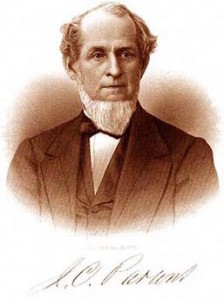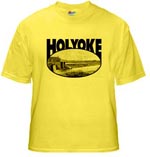by Laurel | March 5th, 2014
05 March 1905
The Movement to Build It — Revenue and Lower Rates
— Result of City’s Enterprise Proved Extremely Successful.
the city of Holyoke holds a unique position among her sister cities of the commonwealth in that she is part owner of a very prosperous railroad, built on money for which she floated the loan. The organization of the company is still kept up and at its meetings the city is each year represented by five directors chosen annually known as the city’s agents. That road is now known as the Holyoke and Westfield branch of the new York and New Have railroad; but at the time that it was built it was leased to the old “Canal” road because it parallels for a great part of its course the bed of the old canal that at one time extended from Westfield and Northampton to tidewater. Recent events in Holyoke have brought the history of the road, the lease by which it became a part of the New Haven and Northampton system, and later a part of the big “Consolidated” lines, very prominently into the public eye. This as especially due t a tentative proposition that the stock of the road owned by the city be sold. Without attempting to judge as to the merits of the proposed sale or to comment thereupon except to note that the plan of selling the stick has practically been abandoned, the history of the building of the road, conditions that surround the city’s holdings and such stories from the records of the town and city as through light upon the road’s history, together with a number of reminiscence from men who played a part in it, will be found below.
At the time of the passage of the act which enabled the city to take stock in the road that was proposed to be built from Holyoke to Westfield (1869) Holyoke was just on the border land between town and cityhood. The population of that year was not far from 10,000; the following year it was 10,733, nearly doubling the population of 1865, which was only 5618. It was a year f expansion all through the country, and Holyoke manufacturers and business men were thinking then of the larger Holyoke. Tradition says that one of the impulses that led to the building of the road was the fact that Timothy Merrick, one of the foremost manufacturers, was insulted by an official of the old Connecticut River Road one day. After that, Mr. Merrick was one of the ardent supporters of the plan for the new road. However this may be, the older manufacturers of the city agree that the old Connecticut River railroad management was very arbitrary in its dealing with the Holyoke business men and manufacturers. There was, and had been for years much grumblings. There was no competition, the River road having all the trackage, and being very independent and “uppish” in its treatment of the shippers. These facts helped the movement though whether in the economic evolution of affairs the road would not have been built anyway is of course an open question. At any rate, the shipper saw in the proposition of a new road a chance to get rates lower and assuredly better treatment. “Better treatment” was the principal point aimed at, and the shippers got it in time and better rates as well.
“The Newtons,” as James H., John C. and Daniel H. Newton were familiarly called in Holyoke’s earlier days, had much to do with the building up of Holyoke, and they were early interested in the plan for the Holyoke and Westioeld road. James H. Newton was on the first board of agents for the city — then a town. John C. and D. H. Newton were bidders on the contract for construction of the 10¼ miles of railroad. Their price was $25,000 lower than that of C. N. Yeamans, representing the New Haven and Northampton company, and it is said that Yeamans was somewhat vexed about it. However, the Newtons agreed to withdraw their bid if the New Haven people would build the road for the same figure which they agreed to do, so the city was really saved $25,000 by the Newtons taking a hand in affairs. As a matter of fact, it was also a good thing that the Canal road built the Holyoke branch knowing as they did its importance and holding a lease in perpetuity, they expended much more money than the contract priced called for — according to the railroad commissioners some $60,000 more — abolished grade crossings, put in what were then heavy rails, and avoided sharp curves. the grades could not be avoided, but they made the best of them.
When the site for the freight and passenger station and railroad yard was selected the Newtons figured again. They had bought the big Bigelow property getting in just 24 hours ahead of the Holyoke Water Power company. There may have been other occasions when Holyoke individuals have gotten ahead of the Holyoke water-power company in a business transaction, but they do not readily occur to one. This was sold to the company for about 25 cents a foot, which was considered to be a modest price. There is no other record as to who should be given the credit of obtaining the favorable clause in the lease by which the city received 50 per cent of the gross receipts, but from the best of the recollection of James H. Newton it was due to J. C. Parsons and William Whiting. Mr. Parsons was the older man and one of the shrewdest manufacturers of the day, and the idea is more likely to have been his originally But both Mr. Parsons and Mr. Whiting were strenuous for it. Some of the agents were inclined to favor a 30-years’ lease rather than one in perpetuity, but it is certain that the lease in perpetuity was the wiser, as at the expansion of 30 years (about 1901) no such favorable lease would be likely to have been executed again. It should be noted that this land for the station and yards was sold to the railroad company for railroad purposes only, and should it be given up for that purpose would revert back to the original holders, the Newtons.
Adapted From The Springfield Republican.









